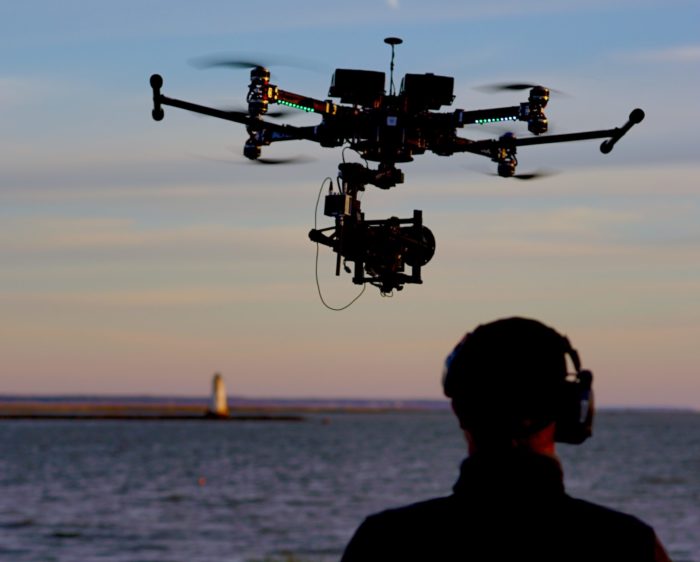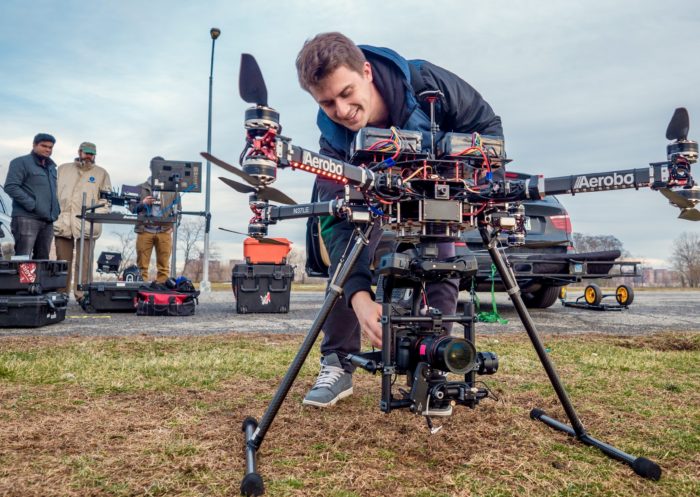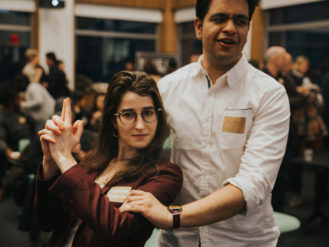Lots of Buzz: How a Brooklyn Drone Service Took Off
For as much as $30,000 a day, Aerobo flies missions for moviemakers, media giants and big business
Outfitted with high-definition video gear, Aerobo's drones can be worth as much as $250,000 (All photos courtesy of Aerobo)
It was a publicity stunt that wouldn’t have been possible just a few years ago. On a sunny day in March, five oversized Oreo cookies hovered over thousands of cups of milk atop a barge in New York Harbor. When they released their payload of regular-size Oreos, the cookies plunged into the milk, some from the height of the Statue of Liberty (305 ft.). The brand wanted to make a big splash for its 105th birthday and it got one, boasting of the “most unprecedented dunk yet.”
The cookie bombers underneath those Oreo costumes were advanced, quad-copter drones flown by a team of pilots from Aerobo, a Brooklyn-based startup. The company is a pioneer in a new industry called drones-as-a-service, which enables customers to hire skilled crews to plan and execute drone flights.
Why would anyone hire a drone, other than for publicity stunts? Lots of reasons, it turns out. Real-estate agencies want scenic overhead video of their properties. Movie and TV producers want breathtakingly long tracking shots to follow the action. Construction companies want 3-D renderings of their future building sites. Agribusiness firms want to check up on their crops.
Drone flying, however, is a sophisticated business, with expensive gear, complex techniques and evolving regulation. “Aerobo was founded on the principle that some commercial companies are going to want to operate their own drones and some are going to want to farm that out to other entities,” said Jon Ollwerther, Aerobo’s chief operating officer. While estimates vary widely, in the next few years the commercial drone business is expected to grow into industry with tens of billions of dollars in annual revenues.
How Aerobo Got Started
The concept that eventually became Aerobo was originally an add-on to an existing company. Brian Streem, co-founder and CEO of Aerobo, was a former NYU film student who was working as a freelance producer. He thought of drones as a great way to move a camera through three-dimensional space. Thinking as a producer, he realized this would free the crew from cranes, cables and other rigging that was costly, time-consuming and potentially dangerous.

A typical Aerobo drone mission is carried out by a team of three: the pilot, the camera operator, and the spotter
“It was clear to me when I started Aerobo that drone technology would change our world, but I didn’t realize how quickly the change would come,” Streem said. “When I founded the company I was busy producing films and TV commercials and began Aerobo as a side project. It quickly gathered steam and absorbed all of my attention and energy.”
The effort paid off. In May 2015, Aerobo raised $685,000 in seed money from investors. That August, the company made the first legal commercial drone flight in New York City, a ten-minute flight above the company’s headquarters in Sunset Park’s Industry City. Last summer, the company raised another round of funding, receiving $184,000 from angel investors. The company has produced video for customers ranging from The Americans TV series to Victoria’s Secret to The Today Show. Aerobo says that it has shot “more live telecasts from a drone than any company in the world.”
To handle its diverse assignments, Aerobo has a network of more than 30 drone operators in New York and other cities, and employs aeronautical and aerospace engineers and videographers. The workhorse for their projects is the Aerobo X8, a custom-built drone that can carry up to 24 lbs. of payload, while keeping the overall weight under the federal limit of 55 lbs. for unmanned aerial vehicles (UAVs). Outfitted with high-definition cameras, a drone system could amount to $100,000 to $250,000 worth of gear flying through the air.
It Takes a Team
A typical Aerobo drone mission is carried out by a team of three: the pilot, the camera operator, and the spotter. The spotter keeps an eye on the overall scene while the other two focus on their main tasks; this can mean something as simple as making the pilot aware of an obstruction he might trip over or watching the air space for flocks of birds.
This professional approach doesn’t come cheap. While a small drone operation doing a relatively simple task (flying over a real-estate development, for example) could do the job for $100 to $200 an hour, Aerobo charges up to $30,000 for a day of work on more complicated projects. The company can justify those prices because it’s “solving a problem,” as opposed to just showing up with a drone and a pilot, says Michael Drobak, a director of the Small UAV Coalition, an industry group. “They provide a soup-to-nuts service that says whatever the problem, we are going to get the equipment and the people that can operate the equipment.” One other merit: Aerobo stays on top of the ever-changing federal and local regulations about drone flights, says Drobak, a senior advisor to the Washington law firm Akin, Gump, Strauss, Hauer and Feld.
Ironically, Aerobo is based in a city where it’s essentially illegal to fly drones commercially. The proximity to airports, buildings and millions of residents rule it out. The company’s inaugural flight at Industry City was legal only because of the location on the waterfront and the permission of the other tenants in the complex. (Amateurs can legally fly drones in designated areas, including Brooklyn’s Marine Park.) While the Federal Aviation Administration is attempting to put overarching federal laws in effect, it has had a hard time customizing those regulations for the differing areas where drones would be used. Rules against flying over people, for example, might not be a big deal in Iowa, but is a much larger issue in Brooklyn.
Being situated in New York City still makes sense for the company, since it’s close to major customers and potential investors. But the restricted airspace over NYC is a source of some frustration to the Aerobo team. “We are on our home turf here,” says Ollwerther. “It’s a company funded and backed by angels and venture money from New York, it’s a company that was started by New Yorkers, staffed by New Yorkers for New Yorkers in New York–and we can’t fly in New York.”
Streem tells about Aerobo's business and shows innovative drone video at a business conference (Video by Hardwired NYC)
The evolving regulation is influenced by consultants like Mark Foley, CEO of Foley Strategies, a retired Air Force pilot with experience in running the military drone programs that preceded the commercial industry. “They were the scary ones,” he said. “The Predators and Reapers you hear about shooting guys in Iraq.” Foley now works as a commercial-drone pilot, trainer of pilots, and has advised the FAA on how to draft the laws to govern commercial drone usage. Some of those laws are quite restrictive, such as not allowing untethered (autonomous) flight and flying beyond line of sight.
A prospective drone pilot can get a federal license simply by passing a 60-question test, but the learning curve is steep, says Foley. “Biggest challenge for new remote pilots is really understanding airspace without actually flying in it. Hard to appreciate its complexity when you are standing on the ground.” Still want to be a pilot? If you’re a good candidate, Aerobo has a proprietary training program to help you earn your wings.













